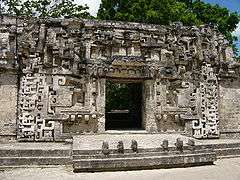Chicanná
| Location | Becán, Rio Bec, Mexico |
|---|---|
| Region | Rio Bec |
| History | |
| Abandoned | 1100 A.D. |
| Events |
Conquered by: Maya Civilization |
| Site notes | |
| Archaeologists | Jack D. Eaton |
| Architecture | |
| Architectural styles | Buildings |


Chicanná was a Maya town that was built during the Classic period 600 A.D. to 830 A.D. The site was named after its most famous building, Structure II, which means "House of the Serpent Mouth" in Mayan. In the Mayan language "chi" means mouth, "can" means serpent and "na" means house. The site is located just two kilometers west of Becán in the Mexican state of Campeche on the Yucatán peninsula. It is one of 45 other ruin sites located within that area.
Chicanná was inhabited from 300 B.C. to 1100 A.D., but was thought to have reached its peak from 300 B.C. to 250 A.D. There is evidence that Chicanná may have been dependent on Becán for much of its existence, since Becán was self-sufficient. Chicanná is one of the most striking examples in the region of the mixing of architectural styles with its stunning detailed buildings. Its buildings have features of the Río Bec, Chenes (Mayan city) and even the Puuc style from the north. It does not have large pyramids, but relatively small buildings with an ornateness and quality of decoration that suggests that it was a center for the region's most elite.
The city of Chicanná is widely known for one of its well-preserved doorways with interesting detail, the city reached its prime during the late classical period. The city of Chicanná is small. However, it is considered to be home for the elites and rulers of Becán. After continuous research on Chicanná site, knowledge grew which eventually lead to the questioning of previous ideas associated with the style of sculptures in central Yucatán. Jack D. Eaton rediscovered Chicanná in 1966 during his exploration of the Yucatán. Chicanná is a site that takes advantage of the natural elevation found in the region so structures seem higher and, for the Maya, closer to the god. This settlement was most used for important spiritual ceremonies and rituals for the Mayans.
References
- Rider, Nick (2010). Yucatan & Mayan Mexico. MA: Interlink Publishing Group. ISBN 978-1-56656-795-4.
"Chicanná Ruins." Locogringo. N.p., n.d. Web. 26 Feb. 2015. <Chicanná Ruins>.
Potter, David F. Prehispanic Architecture and Sculpture in Central Yucatán. Vol. 41. Washington Dc: Society for American Archaeology, 2013. 430-34. Web. 27 Feb. 2015. <http://www.jstor.org/stable/279010?seq=1#page_scan_tab_contents>.
Benchwick, Greg. Lonely Planet Cancun, Cozumel & the Yucatán. 5thth ed. Oakland: Lonely Planet, 2010. 219. Web. 27 Feb. 2015. <https://books.google.com/books?id=EAC0NemtAr4C&printsec=frontcover&source=gbs_ge_summary_r&cad=0#v=onepage&q&f=false>. https://www.locogringo.com/mexico/ways-to-play/mayan-ruins-archaeological-sites/chicanna-ruins/
http://www.bluffton.edu/~sullivanm/mexico/chicanna/chicanna.html
External links
![]() Media related to Chicanna, Campeche at Wikimedia Commons
Media related to Chicanna, Campeche at Wikimedia Commons
Coordinates: 18°30′25″N 89°29′11″W / 18.5069°N 89.4863°W
